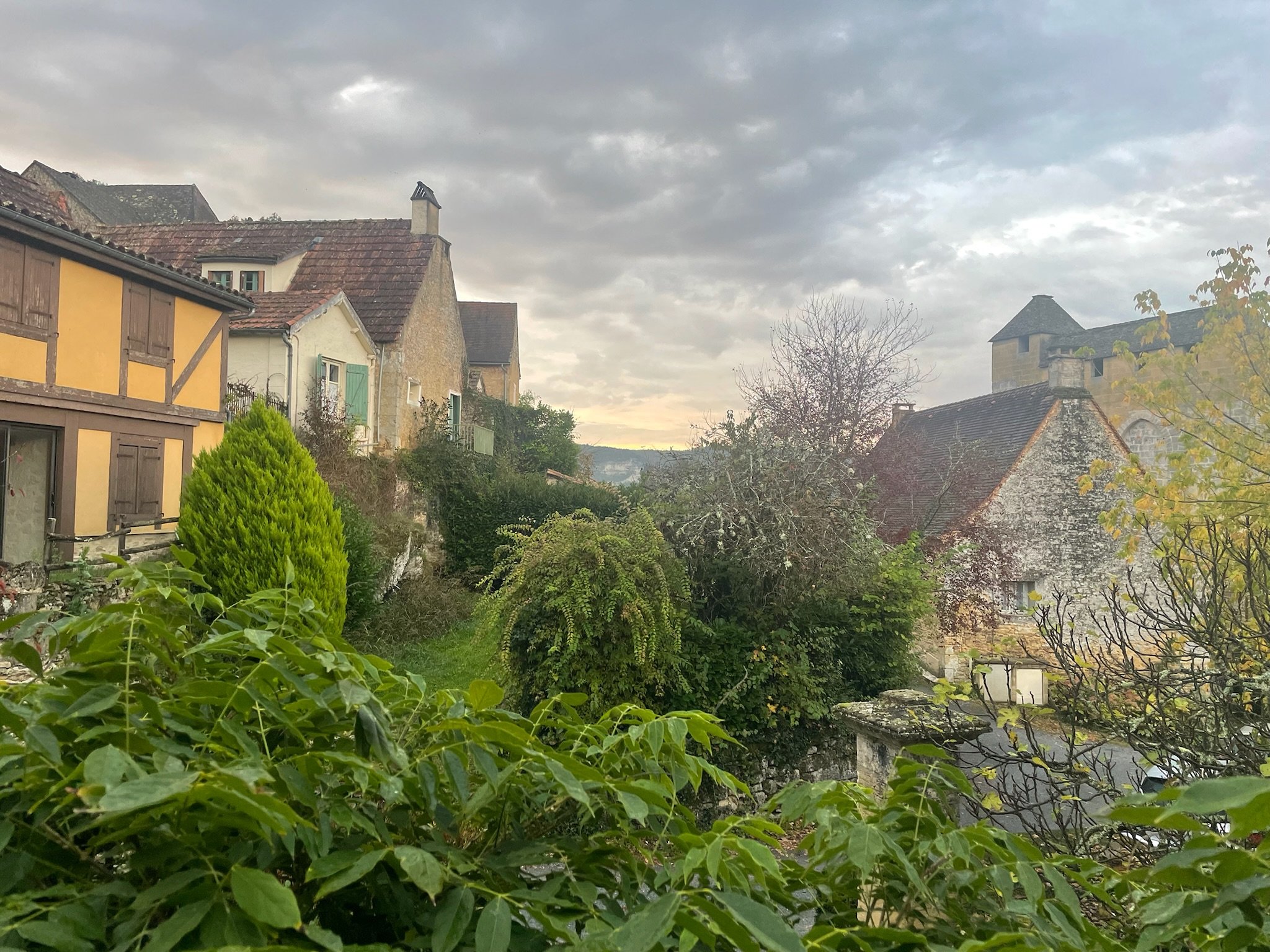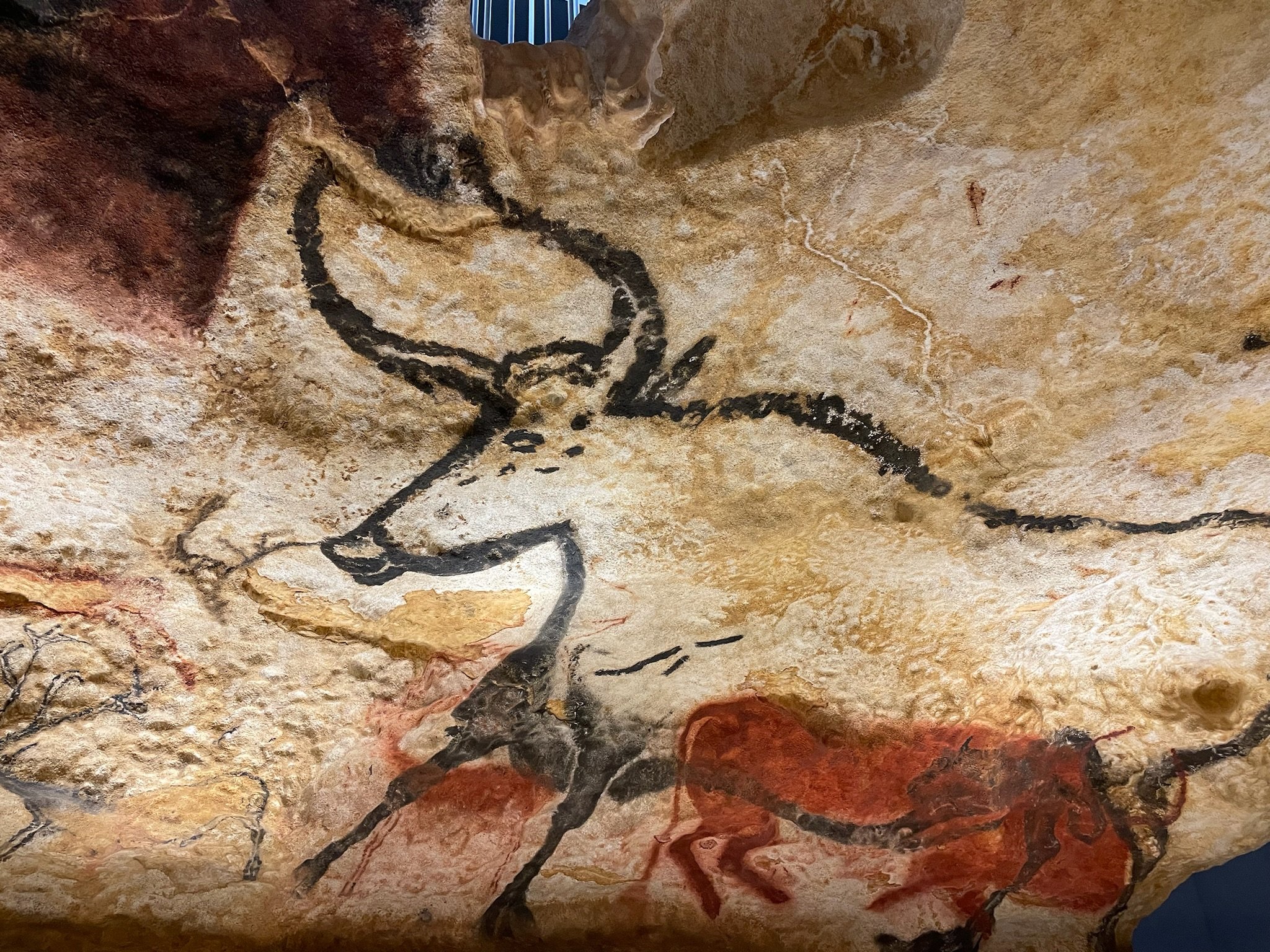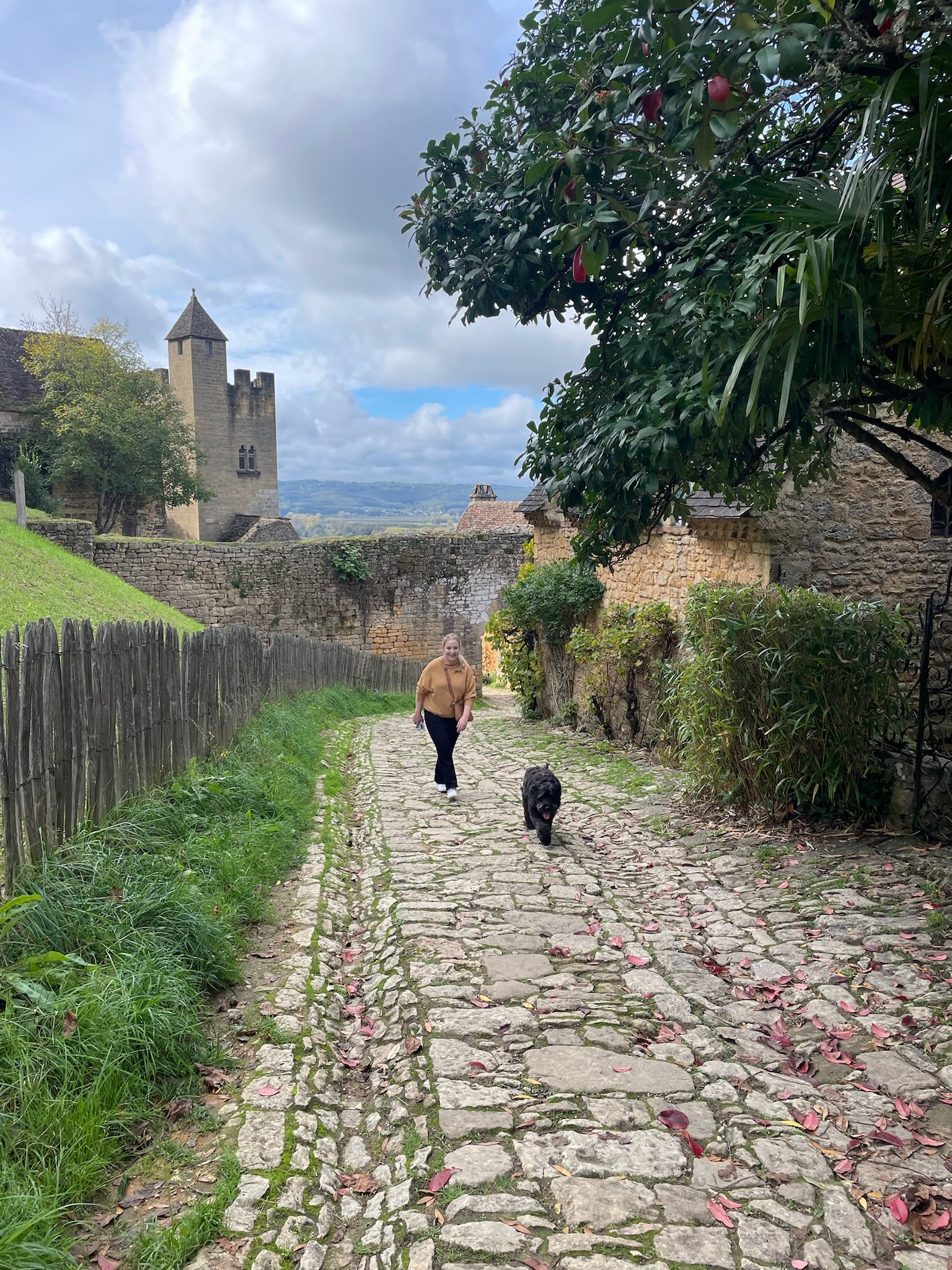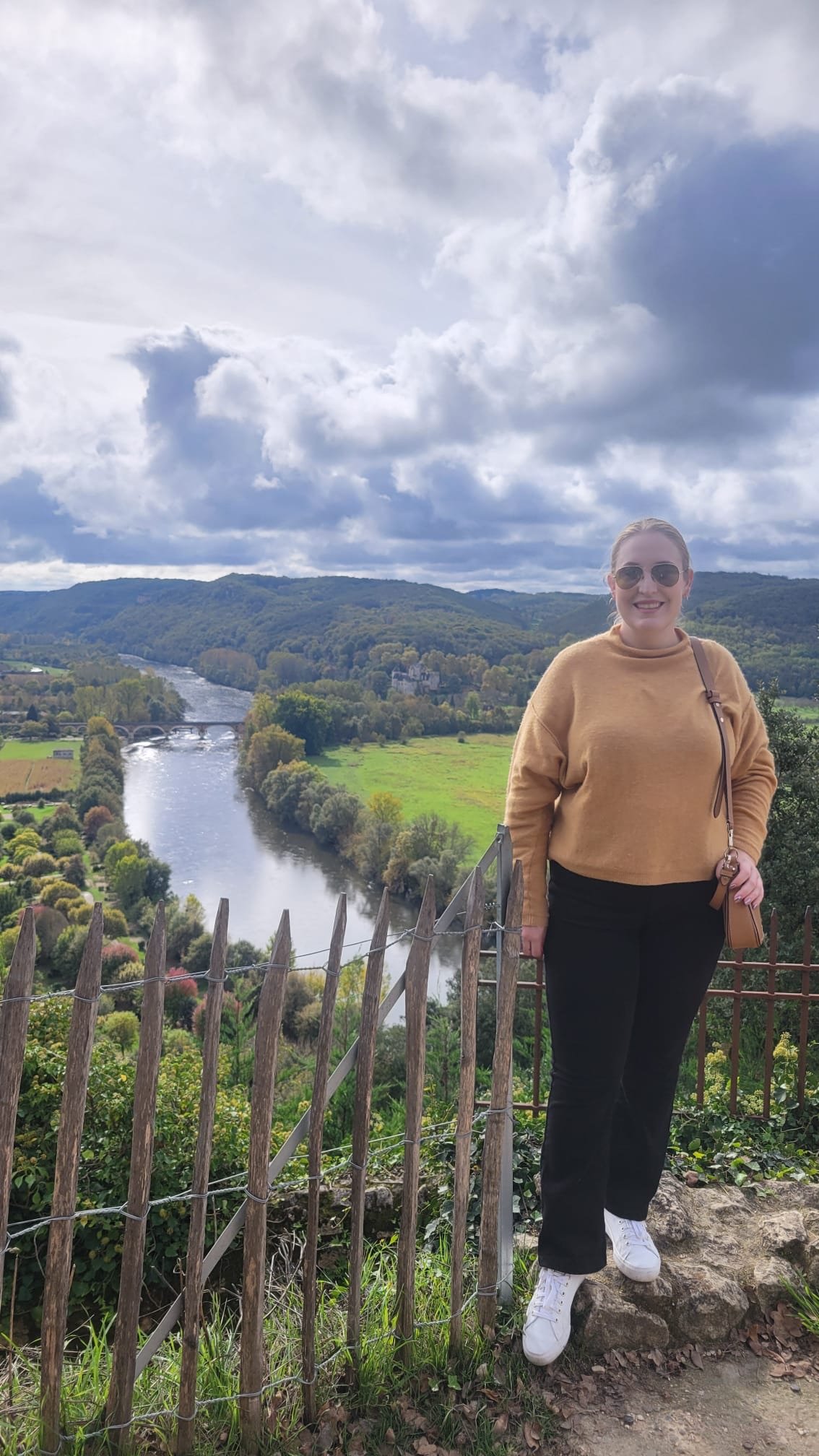Dordogne (T 55 – 62)
Alsace was a gem, but Dordogne was the hidden gem of the trip. I chose Dordogne primarily because I had a recommendation for a French language teacher there and it was a region I had barely heard about, but what little I’d heard, was positive. It turned out to be more than positive, it was magical.
We set out on a Saturday morning from Eygalières to Les Ezyies-de-Tayac via Toulouse, the longest car trek of the trip, roughly 7 hours but mostly autoroute. We were treated to a small peek of the Pyrenees in the distance as we passed near Toulouse, but it was in the last two hours that the landscape changed to deeply forested canyons and lush, meandering river valleys. As we exited the autoroute, we passed through rolling, wooded hills, quiet villages, limestone outcroppings, and the occasional livestock fields and duck farms. And a few chateaux that appeared out of nowhere. We could tell we were somewhere different and special.
Les Eyzies-de-Tayac
Les Eyzies and Tayac were two separate but neighboring villages on the banks of the Vézère river which were consolidated over a century ago. The oldest, Tayac, is now a commune of 7 residents and a little church; Les Eyzies is what most tourists see and while still a small village by all accounts, is comprised of shops, restaurants and a stunning Museum of Prehistory built into an impressive rock outcropping. Our French teacher, Chantal, owns a gîte (cottage for rent) within her property in Tayac which she rents out primarily to her students. It was rustic, ample, and comfortable, and she invited us to have the run of her beautiful garden. It turned out to be quiet and secluded but close enough to Les Eyzies and easy enough to get on the road to visit other villages. Chantal was kind, charming, helpful, unabashedly French, and an excellent teacher.
We loved our weeklong stay there. Sophia and I each had 1-hour French lessons first thing in the mornings and as soon as we were done, the four of us would take off to explore. It made for some long drives a couple of the days, but it was a great balance. These are the spots we had on our agenda:
Lascaux – Montignac
The Lascaux caves, near the village of Montignac, are said to be the most famous prehistoric caves in the world. They contain stunning Palaeolithic cave paintings, thought to be about 17,000 years old. The original caves were closed to the public years ago in order to prevent damage, but a near-identical cave replica and museum was built nearby which we were able to tour followed by a walk and lunch in Montignac.
Grotte de Font-de-Gaume
Nearer to us in Les Eyzies, the Grotte (cave) de Font de Gaume is a Unesco World Heritage Site and an original Paleolithic sanctuary still open for viewing by guided tour only. It contains over two hundred painted or engraved figures of bison, horses, mammoths, and reindeer. The number of visitors and the number of guided tours is quite limited, but we were lucky to get spots during our stay. Because the paintings can get damaged by touch, and the cave can be quite narrow at points, the tour itself was a bit of an awkward dance of standing close to strangers and moving through passageways in tiny steps to avoid brushing against the cave walls. Our tour guide took a liking to us and while the others filed out at the end, showed us a couple painted handprints as an extra treat. It was a surreal experience to know these were painted by humans 17,000 years ago. Pictures inside were not allowed.
Bergerac Wine Tour
Outside the well-known wine region of Bordeaux, there are other smaller, lesser-known appellations that are making their name in the wine business. We found a British sommelier who organizes small tours around Bergerac and we signed up for an afternoon tour after our morning lessons.
We visited two wineries – one, Château de Fayolle, purchased very recently by an American former tech CEO and his wife, and the other, Château de Peyrel, restored by the descendant of prior vintners and now known for award-winning experimental blends and processes.
At the former, we enjoyed a wonderful outdoor lunch with an amazing charcuterie board and yummy Rosé, plus of course a tasting of their line of whites and reds; at the latter we had a mini private tour given by the actual owner and vintner who took us to his vineyards, to his production and aging area, and gave us a tasting in his own dining room. We tasted some truly unique wines, including one I brought home for Steve and Austin which had strong cognac notes.
Villages
The villages in the Dordogne were out of fairy tales. Everything – the surroundings, the landscape, the limestone outcroppings, the medieval buildings, the overflowing greenery, the riverbanks, the cobblestones – all came together into indescribable beauty. Even pictures don’t do them justice, but below is a sample of those we visited. We were 20 minutes from Sarlat, and the other villages of Beynac, La Roque Gageac, and Domme were within an additional 20-minute drive. The farthest out (and actually in the department of Lot, not Dordogne) was Rocamadour and the Gouffre de Padirac, but also worth the 1 ½-hr drive each way.
Beynac-et-Cazenac
Beynac and its neighbor Cazenac are beautiful villages known for their stunning medieval architecture and cliffside setting. The Château de Beynac is their centerpiece, which perched high on a limestone cliff overlooking the Dordogne river, served as a strategic stronghold during the Hundred Years’ War. But for us, it was the breathtaking views of the valley and neighboring castles from atop the hill that sealed the deal.
Beynac-et-Cazenac was a filming location for several movies, including “Joan of Arc” (1999) and “Chocolat” (2000). Not surprising given all its charm.
La Roque Gageac
Nestled at the foot of limestone cliffs beside the Dordogne River, this village is also known for its unbelievable setting with houses built high up into the cliffs. We had a nice lunch there and then took a 1-hour boat ride on the river where we got beautiful views of La Roque, the surrounding forests and castles, and Beynac in the background.
Domme
On our French teacher’s recommendation, we drove up to Domme, a bastide town with more stunning, panoramic views of the Dordogne Valley, the other nearby villages, and surrounding castles. We had a nice walk-around, visited their little library, and of course took lots of pictures.
Sarlat le Canéda
A UNESCO World Heritage-listed town, Sarlat is famous for its well-preserved medieval architecture and a vibrant Wednesday market. We were able to get there early enough to catch the market and buy some prints, plus had lunch at a longstanding restaurant with amazing duck confit.
Le Gouffre de Padirac
The Gouffre de Padirac, technically in the Lot department, is a massive sinkhole and underground cave system with stunning stalacites, stalagmites, and other formations. We took a couple of elevators down the sinkhole (338-feet down), then descended more stairs to the subterranean river, which flows through the cave system for nearly 2 km. We boarded a small Gondola-like boat (not as fancy but with a guide to row us) that then took us to another area with incredible formations. More impressive in real life for its breath and scale.
Rocamadour
Outside of Paris, Rocamadour is said to be the 2nd most visited site in France after the Mont St. Michel. It is another impressive cliffside village, but most importantly, a pilgrimage site with multiple sanctuaries, including the Sanctuary of Rocamadour which houses the famous Black Madonna believed to have miraculous powers. It is also where the remains of St. Amadour were said to have been found relatively well-preserved and is part of one of the Ways of St. James (Camino de Santiago).
Shout out to the food!
The Dordogne region is known for its foie gras, duck confit, truffles, and all-things-walnut (cakes and oils in particular). Need I say more? I think I topped out at 4 duck confits in the span of 1 week.
Bordeaux to Paris
It was starting to feel bittersweet and the finality of our journey hit us more strongly here. We said au revoir et à bientôt to the Dordogne, driving in early morning darkness, fog, mist, and then flat-out rain from Tayac to Bourdeaux to drop off our car and take the high-speed train to Paris for our final week.













































































